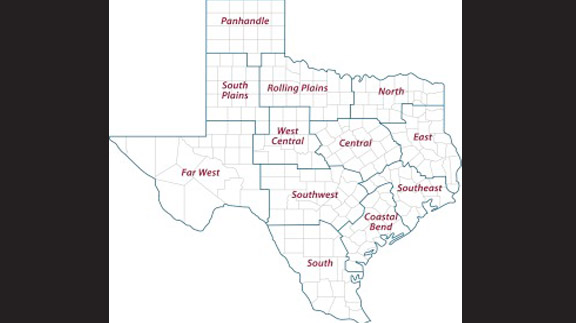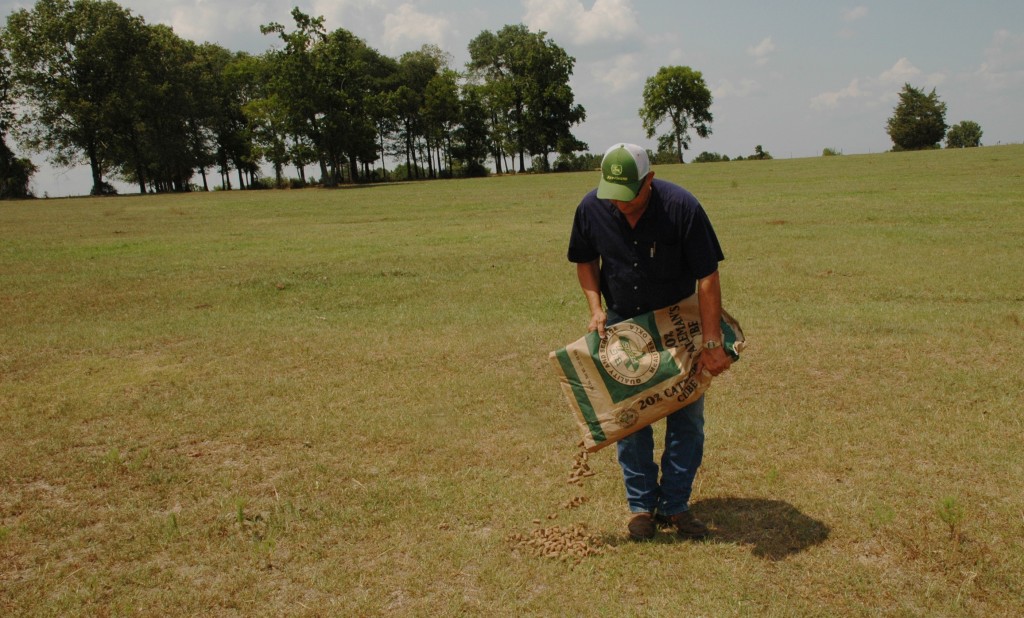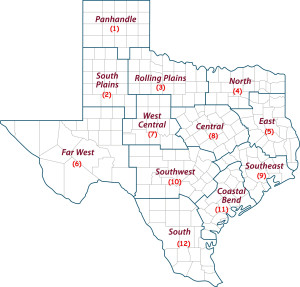Farm & Ranch
Texas AgriLife Today crop, weather report for Oct. 20, 2015

By: Robert Burns
State climatologist: Rain forecast more a prelude than ‘true’ El Niño
Writer: Robert Burns, 903-834-6191, [email protected]
COLLEGE STATION – The forecast of rains for Texas this week will be music to many farmers and ranchers ears, but the coming stormy weather is not the main El Niño event, according to a climatologist.
It’s more like a prelude, said Dr. John Nielsen-Gammon, state climatologist and Regents Professor at Texas A&M University, College Station.
Texas is sure to get some rainfall, Nielsen-Gammon said. There’s an upper-level disturbance moving into the southwest, and a tropical cyclone in the Pacific off the coast of Mexico should feed some moisture into the state. Though El Niño may be contributing to the storms, it’s not the beginning of the main activity: the near-normal to wetter-than-normal fall and winter that climatologists are expecting.
But the coming wet weather doesn’t mean things have been normal so far, he said. At least 22 counties in Texas have received record low rainfall in the past 90 days. Rainfall the third week in October may help, but it is only expected to average about 2 inches statewide, which may not be enough to end the drought many parts of the state are experiencing.
“In Texas, we never really have ‘normal’ weather,” Nielsen-Gammon said. “But some of the strongest El Niños in the past have been associated with dry Septembers and Octobers. So it’s not too surprising this time around that we have to wait until later in October for enhanced rainfall chances. That’s actually how it normally works. We don’t usually get a big impact from El Niño until the jet stream is far enough south to affect our weather.”
AgriLife Extension district reporters compiled the following summaries:
Central: Soil moisture, rangeland, pastures and crops were in poor condition. Livestock remained in good condition with supplemental feeding. Cold fronts moved through the region, bringing lows in the 50s and highs in the 80s, but the region remained extremely dry. Winter grasses needed rain, as did crops, stock tanks and rivers. Irrigated small grains were under attack by armyworms. The dry weather along with windy conditions raised the risk of grass fires.
Coastal Bend: The region had warm, dry weather with low humidity. The wildfire danger was high, and burn bans were instituted in most counties. Most row crops and rice fields were readied for the fallow season. Winter pasture planting slowed as producers waited for improved soil moisture. Pastures were suffering due to dry conditions. Pecan growers were harvesting and reporting fair yields. Fall cattle work was underway, and calf sales were brisk.
East: With no measurable precipitation, drought conditions continued to worsen throughout the region. Pastures were drying up. Most counties rated pasture and rangeland conditions as poor or very poor. Only a few counties reported adequate subsoil and topsoil moisture; most reported short or very short conditions. With low humidity and strong southwesterly winds, the wildfire danger was extremely high. There were wildfires in Gregg and Marion counties. Some pastures were evacuated due to lack of water for cattle to drink. Abnormally warm temperatures decreased forage quality. Producers were waiting until rain was in the forecast to plant winter forages. Many producers were feeding hay and supplements earlier than usual. Some producers were already running short on hay. In Trinity County, producers were baling pastures despite an abundance of weeds; others continued to buy hay out of the region. Livestock were in good condition, though some cows were beginning to lose weight due to poor grazing. The cattle market remained down. Producers continued to wean calves and cull cows.
Far West: Cotton harvesting was either in full swing or about ready to start after producers applied defoliants. Grain sorghum and some sugarcane had to be sprayed for sugarcane aphids. Alfalfa growers were taking the last cutting. Onions started to emerge. In Pecos County, about half the cotton was still producing bolls due to late replanting caused by a hailstorm. In Presidio County, rain totals varied from 2 to 4 inches and caused flooding along the Rio Grande River. Producers continued to feed livestock and wildlife. Bucks and rams were put out to pasture and will remain out until early December. Pasture and range conditions varied widely throughout the region.
North: The drought worsened. Topsoil moisture was short to very short, and the wildfire danger was high. Most small grain farmers were waiting for wetter conditions before they started planting. Some ranchers planted winter annual pastures, hoping for rain soon to bring the crop up. A few producers were baling late-season hay, but the quality was poor. Though much of the hay baled this year was of low quality, supplies were judged adequate to get most operations through the winter. Some producers were feeding hay already. Cattle were straying off pastures in search of better grazing as forages became scarce. The cotton harvest began. Stock-pond levels dropped. Highly variable temperatures stressed livestock. Feral hog activity increased. Armyworm reports slowed.
Panhandle: The region was dry with cool nights and warm, windy days. Rain was needed throughout the region. In Collingsworth County, the warm, dry weather aided peanut harvest. Much of the peanut crop had been dug, and yields were expected to be average to slightly above average. Late-planted cotton was catching up in maturity, and harvesting should begin soon. Wheat planting was stalled until more moisture was received. Deaf Smith County producers were trying to continue harvesting crops. After the rain of 1.5 to 4 inches the previous week, fields were just beginning to dry out enough for equipment not to be bogged down. Silage choppers were running, but only with the help of tractors pulling trucks through the field. The corn harvest resumed on drier fields. Producers began planting winter wheat again, and the earliest planted wheat was up and looked good. There was some grain sorghum being harvested with good yields. The Hall County cotton harvest began. Yield and grade reports were promising. Rain was needed for pastures and wheat. Except for cotton, the Hansford County harvest continued. A large part of the corn crop had dried out. Dryland sorghum was making from 1,000 to 1,500 pounds per acre, and irrigated corn for silage was making as much as 3,000 pounds per acre. Ochiltree County wheat growers were planting at a rapid pace. Germination and emergence of wheat was excellent due to previous rains and warm temperatures. The dry weather and warm temperatures also meant the corn, sorghum and soybean harvest could continue at a brisk pace. Yields were excellent, though some sorghum fields had lodging. Forage supplies were excellent going into winter, and most haying operations were done. Cattle were in excellent condition. Oldham County ranchers were shipping cattle off pastures to feed yards. Early planted wheat looked good. Randall County weather was also ideal for harvesting. The corn harvest was nearly complete with average yields — from 160 to more than 200 bushels per acre. The sorghum harvest was in full swing, with yields averaging from 4,000 to 6,000 pounds per acre. Cotton harvesting began.
Rolling Plains: Some areas received light showers. The storms were accompanied by lightning that caused a few grass fires that were quickly contained with the help of the rain. However, the rain wasn’t enough to help pastures much but settled the dust for a day or two. With cotton opening bolls and harvesting beginning in some areas, moisture wasn’t what farmers wanted. Only a few farmers had defoliated their cotton crop and began stripping cotton. However, cotton harvesting was expected to be in full swing within a week or two, depending on the weather. With forecasts calling for an El Niño winter, ranchers hoped there would be enough moisture to help get this year’s wheat crop up and ryegrass winter pastures going. Many farmers decided to sow part of their wheat acres despite extremely dry soils and record-breaking high temperatures in the upper 90s. Many of the records broken were set 30 to 50 years ago.
South: Temperatures in parts of the region were abnormal for this time of the year – well into the 90s during the day. Some areas received rain, which gave relief from the hot weather and slightly improved soil moisture. In the northern part of the region, producers began harvesting peanuts and planting wheat and oats. Rangeland and pastures remained in fair to good condition. Supplemental feeding of livestock was further increased as pasture quality continued to decline. Cattle remained in fair shape. Frio County had 50 percent adequate topsoil and 100 percent very short subsoil moisture. La Salle County reported 80 to 90 percent adequate soil moisture, and McMullen County had 100 percent short soil moisture. In the eastern part of the region, 90-degree temperatures caused range and pastures to further decline. Livestock producers expected to have to begin supplemental feeding of cattle soon. There was an increase in cattle offered for sale as winter approached. Soil moisture was 40 percent very short in Duval County. Jim Wells County had 50 percent adequate subsoil and 75 percent short topsoil moisture. Kleberg and Kenedy counties had 50 percent adequate subsoil and 60 percent short topsoil moisture. In the western part of the region, native plants responded well to substantial rains from the week before. Grazing conditions were fair to good. The ample moisture also gave newly emerged oat and wheat fields a boost. Spinach, cabbage, carrots and onions progressed well. Pecans were developing nicely, and harvesting was expected to begin in the next couple of weeks. Soil moisture was very short in Dimmit County and adequate in Maverick County. In Zavala County, subsoil moisture was 100 percent adequate and topsoil moisture 100 percent short. In the southern part of the region, recent rains benefited rangeland and pastures. Fall crops were progressing well, and land preparations for November plantings continued. In Hidalgo County, winter vegetable planting continued, and cotton stalks were being plowed under. Hay baling operations continued in Starr County. Subsoil moisture was 60 percent adequate and subsoil moisture 40 percent short in Cameron County. In Hidalgo County, subsoil moisture was 100 percent adequate and topsoil moisture 70 percent adequate. In Starr County, both subsoil and topsoil moisture were 90 percent adequate.
South Plains: The Floyd County cotton harvest started. Most cotton was already sprayed with defoliants — or will be sprayed in the next few days to a week. Lubbock County had drier but cooler fall weather, allowing harvesting to resume in grain and cotton fields. About 40 percent of the county’s cotton fields were defoliated. Cotton grades thus far showed good staple and micronaire. Cochran County topsoil and subsoil moisture remained adequate. Garza County got rain, from a trace to nearly 0.5 inch, which interrupted the cotton harvest for a few days. The harvest resumed soon with better than anticipated yields. Temperatures were abnormally high for the season, ranging in the 80s and 90s until late in the reporting week. Range and pastures benefited slightly from the rainfall, but more was needed to help forage production. Livestock were in excellent condition. In Mitchell County, the cotton harvest was in full swing. Producers were spraying and stripping, trying to get cotton out before winds or heavy rains damaged the cotton. After last week’s rain, much more wheat was planted. Producers planned to continue planting ahead of the upcoming rains. Scurry County was still dry, and producers hoped for the forecasts of rain to be true. Some cotton was defoliated, and harvesting began.
Southeast: Soil moisture throughout the region varied widely but was mostly short to very short, with very short being the most common. Rangeland and pasture ratings varied from fair to very poor, with poor ratings being the most common. The area remained rainless, but temperatures became more moderate. Some producers began planting winter pastures in hope of receiving rain soon. Burn bans were in effect in most counties. Stock-tank water levels continued to drop. In Fort Bend County, the cotton harvest was wrapped up, and row crop producers were working to get land in shape before the expected winter rains. Pastures and hay fields were very dry. Livestock were in fair to good condition.
Southwest: Some areas received from 1 inch to 10 inches of rain, but for the most part, the region remained hot and dry. Initial cotton harvest numbers indicated higher yields than expected. Small grain growth for grazing was slowed by lack of moisture. Livestock struggled with internal parasites and the lack of green vegetation.
West Central: The region continued to have hot, dry, windy days with mild, cool nights. Record high temperatures and strong winds added to the already high wildfire danger. The cotton harvest was underway and expected to be in full swing within a week. Producers continued to prepare for fall planting, including applying fertilizers to small grain fields. Some producers dry-planted wheat, but saw little to no emergence to date. Wheat that did emerge was struggling due to lack of moisture. Most producers were waiting for rain before planting either wheat or oats. Rangeland and pastures were severely drought stressed. Forage growth slowed considerably. Stock-tank water levels further dropped. Some smaller tanks were already dry, forcing producers to move livestock to locations with accessible water. Livestock remained in fair to good condition with supplemental feeding. Cattle prices were on the increase again.
-30-
Find more stories, photos, videos and audio at http://today.agrilife.org
Farm & Ranch
Acorn Toxicity

By Barry Whitworth, DVM, MPH
With the prolonged drought, most pastures in Oklahoma end up in poor condition. With the lack of available forage, animals may go in search of alternative foods.
If oak trees are in the pastures, acorns may be a favorite meal for some livestock in the fall. This may result in oak poisoning.
Oak leaves, twigs, buds, and acorns may be toxic to some animals when consumed.
To read more, pick up a copy of the November edition of North Texas Farm & Ranch magazine, available digitally and in print. To subscribe by mail, call 940-872-5922.

Farm & Ranch
Silver Bluestems

By: Tony Dean
There are a handful of grasses on North Texas grazing lands ranchers need to know, not because they are highly desirable, but rather because they are not of much value. I call them “decom” plants, which is am acronym for “Don’t Ever Count On Me.” Silver bluestem is a “decom” grass.
Silver bluestem is a perennial which grows in all areas of Texas. It can survive in almost all soil types, and in full sun conditions or in semi shade. It grows up to three feet tall and is easily recognized with the presence of the white fuzzy seed head. Also, one of the identifying characteristics of Silver bluestem is a bend in the stems at each node, causing the plants to take on a rounded shape as they mature.
To read more, pick up a copy of the November edition of North Texas Farm & Ranch magazine, available digitally and in print. To subscribe by mail, call 940-872-5922.

Farm & Ranch
Meanwhile Back At The Ranch

By: Rayford Pullen
Fall is here which means winter is closing in on us and before we officially get into winter, we need to make sure our factories are either producing or will be producing in a few months.
We have been pregnancy testing our cows this fall and if they are not bred or nursing a calf, we are bidding them adios. With annual costs somewhere between $900.00 and $1,000.00 per cow, those cows not producing a live weaned calf are costing us quite a bit.
To read more, pick up a copy of the November edition of North Texas Farm & Ranch magazine, available digitally and in print. To subscribe by mail, call 940-872-5922.
-

 Country Lifestyles2 years ago
Country Lifestyles2 years agoScott & Stacey Schumacher: A Growth Mindset
-

 Country Lifestyles8 years ago
Country Lifestyles8 years agoStyle Your Profile – What your style cowboy hat says about you and new trends in 2017
-

 HOME8 years ago
HOME8 years agoGrazing North Texas – Wilman Lovegrass
-

 Equine1 year ago
Equine1 year agoThe Will to Win
-

 Country Lifestyles5 years ago
Country Lifestyles5 years agoAmber Crawford, Breakaway Roper
-

 Outdoor9 years ago
Outdoor9 years agoButtercup or Primrose?
-

 Country Lifestyles8 years ago
Country Lifestyles8 years agoJune 2016 Profile – The man behind the mic: Bob Tallman
-

 Country Lifestyles8 years ago
Country Lifestyles8 years agoDecember 2016 Profile, Rusty Riddle – The Riddle Way






